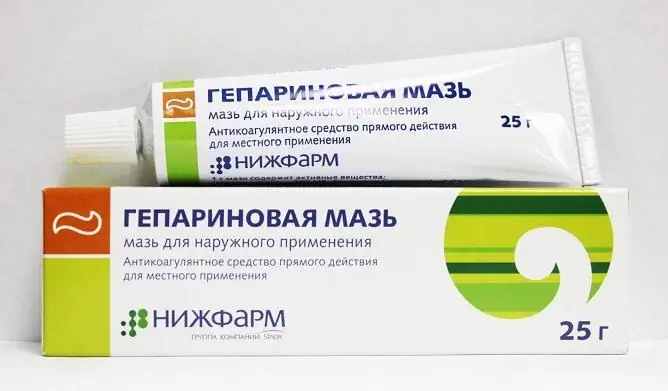- Author Rachel Wainwright [email protected].
- Public 2023-12-15 07:39.
- Last modified 2025-11-02 20:14.
Aceclidine
Aceclidine: instructions for use and reviews
- 1. Release form and composition
- 2. Pharmacological properties
- 3. Pharmacokinetics
- 4. Indications for use
- 5. Contraindications
- 6. Method of application and dosage
- 7. Side effects
- 8. Overdose
- 9. Special instructions
- 10. Application during pregnancy and lactation
- 11. Drug interactions
- 12. Analogs
- 13. Terms and conditions of storage
- 14. Terms of dispensing from pharmacies
- 15. Reviews
- 16. Price in pharmacies
Latin name: Aceclidinum
ATX code: A03FA
Active ingredient: aceclidine (Aceclidinum)
Manufacturer: Vector State Research Center of Virology and Biotechnology (Russia)
Description and photo update: 2019-26-08

Aceclidine is an active cholinomimetic with a miotic effect.
Release form and composition
Dosage forms:
- solution for subcutaneous injection 0.2% (in ampoules of 1 ml and 2 ml);
- eye drops: contain a different percentage of the active substance, are made from powder in pharmacies;
- eye ointment 3% and 5% (in tubes of 20 g).
The active ingredient of the drug (in all dosage forms) is aceclidine.
Pharmacological properties
Pharmacodynamics
Aceclidine is a cholinomimetic that has a predominant effect on m-cholinergic receptors. The chemical structure is a derivative of 3-hydroxyquinuclidine.
It has a pronounced miotic effect, which is accompanied by a decrease in intraocular pressure; increases tone and leads to increased contractions of the bladder, intestines, uterus. With therapy in high doses, it can cause a decrease in blood pressure, bradycardia, bronchospasm, and increased salivation.
Pharmacokinetics
The drug is easily absorbed by various routes of administration (including instillation into the conjunctival sac). Penetrates the blood-brain barrier.
Indications for use
- atony of the bladder associated with neurogenic disorders (most often with an increase in the volume of residual urine);
- atony of the muscles of the gastrointestinal tract;
- decreased tone and subinvolution of the uterus (in order to stop bleeding in the postpartum period).
When X-ray examination of the stomach, esophagus and duodenum 12, the solution is used as a diagnostic tool.
In ophthalmic practice, the drug is used to reduce intraocular pressure and constriction of the pupil.
Contraindications
- bronchial asthma;
- chronic heart failure stage II - III;
- angina pectoris;
- bleeding from the gastrointestinal tract;
- epilepsy;
- hyperkinesis;
- pregnancy;
- inflammatory processes that occurred in the abdominal cavity before surgery;
- hypersensitivity to the drug.
Instructions for the use of Aceclidine: method and dosage
The scheme of using Aceclidine is determined individually, depending on the indications.
When atony of the intestines, stomach, bladder and hypotension of the uterus, 0.2% solution is injected subcutaneously, 1-2 ml. In case of insufficient effect, the drug is re-injected with an interval of 20-30 minutes.
Higher dosages for adults: single - 4 mg, daily - 12 mg.
Diagnostic tests:
- to detect achalasia of the esophagus, the patient is injected with 0.75-1 ml of solution 15 minutes before taking the barium suspension;
- to clarify the nature of the lesion of the stomach and duodenal ulcer, after the usual X-ray examination, 0.5-1 ml of solution is injected. After 12-15 minutes after taking an additional portion of the barium suspension, a second study is carried out.
In ophthalmic practice, aceclidine drops and ointment are used topically.
Eye drops are instilled 3-6 times a day, the hypotensive effect after instillation lasts up to 6 hours. After the instillation procedure, the area of the lacrimal sac should be pressed for several minutes to prevent the solution from flowing into the nasal cavity through the lacrimal canal.
Side effects
- allergic reactions;
- irritation of the conjunctiva;
- vascular injection;
- aches and heaviness in the eye.
With subcutaneous administration in high doses, symptoms associated with the m-cholinomimetic action of Aceclidine may appear, including increased sweating, salivation, diarrhea. For treatment, atropine, metacin or other m-anticholinergics are used.
Overdose
The main symptoms are salivation, diarrhea, and sweating.
Therapy: the use of atropine, metacin, other m-anticholinergics.
special instructions
In ophthalmic drops and ointment, Aceclidine can be used simultaneously with other miotics.
For parenteral administration, the use of eye drops is unacceptable.
Application during pregnancy and lactation
According to the instructions, Aceclidine is not prescribed during pregnancy.
Drug interactions
No interaction data available.
Analogs
Analogs of Aceclidine are: Cerucal, Glaucostat, Motilium, Domet, Domperidone, Ganaton, Perinorm, Dimetramide, Glaudin, Motonium, Ceruglan, Damelium, Motilak, Melomida hydrochloride, Itomed, Metoclopramid, Itopra, Motectra, Motepramide.
Terms and conditions of storage
The shelf life is:
- solution for injection - 2 years;
- eye ointment - 1 year.
Terms of dispensing from pharmacies
Dispensed by prescription.
Reviews about Aceclidine
There are no reviews of Aceclidine, since the drug has not been used in clinical practice for a long time.
Price for Aceclidine in pharmacies
The price of Aceclidine is unknown, the drug is not produced or sold in the pharmacy chain.

Anna Kozlova Medical journalist About the author
Education: Rostov State Medical University, specialty "General Medicine".
Information about the drug is generalized, provided for informational purposes only and does not replace the official instructions. Self-medication is hazardous to health!






